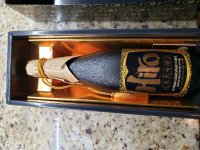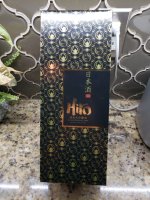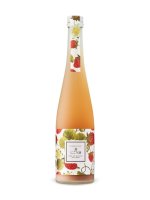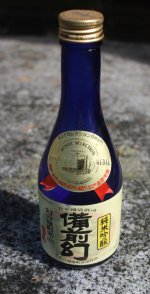Sake
- Thread starter shanez
- Start date
You are using an out of date browser. It may not display this or other websites correctly.
You should upgrade or use an alternative browser.
You should upgrade or use an alternative browser.
SmokingPipes.com Updates
Watch for Updates Twice a Week
Sake comes in various grades, depending on how much of the rice grain is milled (removed)I dont know if Ive ever had higher grades of it but what Ive had I wasnt crazy about. I couldnt seem to develop a taste for it.
Taste can be subtle, but differences can be discerned if tasting them side-by-side
Warm sake is the crap they serve to Americans that don't know any better.
Good to great sake is served cold.
There are four ingredients to make sake: rice, water, yeast and koji.
Special rice, called “sakamai,” is used for making sake and is prepared through rice polishing.
Better quality sakes will show an RPR percentage on the label. RPR = Rice Polishing Ratio.
60% RPR means that 60% of the grain of rice is left after polishing.
RPR is one factor that effects the price. An average good sake will have a 70-60% RPR.
A sake that has an RPR of 30% will be much higher priced. Since only 30% of the grain is left, it will take a lot more rice to make the same amount of sake.
Koji turns starchy rice into sugar that is fermentable.
Yeast turns the sugar into alcohol.
Btw, koji is also used to make miso, soy sauce, and mirin.
Good to great sake is served cold.
There are four ingredients to make sake: rice, water, yeast and koji.
Special rice, called “sakamai,” is used for making sake and is prepared through rice polishing.
Better quality sakes will show an RPR percentage on the label. RPR = Rice Polishing Ratio.
60% RPR means that 60% of the grain of rice is left after polishing.
RPR is one factor that effects the price. An average good sake will have a 70-60% RPR.
A sake that has an RPR of 30% will be much higher priced. Since only 30% of the grain is left, it will take a lot more rice to make the same amount of sake.
Koji turns starchy rice into sugar that is fermentable.
Yeast turns the sugar into alcohol.
Btw, koji is also used to make miso, soy sauce, and mirin.
What surprises me is that something as savory and slightly nutty tasting as rice can be made into a such a floral and fruity beverage.
The makers of any beverage can suggest a serving temperature, but like pipe tobaccos being wet or dry, it’s really up to your own palate.
Regardless there is something about sake that gives me a headache a few hours after a glass. Maybe msg from the food paired with something in the sake. IDK
The makers of any beverage can suggest a serving temperature, but like pipe tobaccos being wet or dry, it’s really up to your own palate.
Regardless there is something about sake that gives me a headache a few hours after a glass. Maybe msg from the food paired with something in the sake. IDK
MSG is a whole other topic, and the headache thing is a myth created by racism. If you want to discuss that, let's start a new thread. I'm happy to let it go though.What surprises me is that something as savory and slightly nutty tasting as rice can be made into a such a floral and fruity beverage.
The makers of any beverage can suggest a serving temperature, but like pipe tobaccos being wet or dry, it’s really up to your own palate.
Regardless there is something about sake that gives me a headache a few hours after a glass. Maybe msg from the food paired with something in the sake. IDK
I do not get headaches just from Chinese food, It is our goto for delivery. I certainly didn’t mean to suggest anything racist. I only brought the headaches up as a reason why I haven’t pursued sake any further than tastes. And, it certainly has some fantastic flavor that I didn’t expect when tasted.MSG is a whole other topic, and the headache thing is a myth created by racism. If you want to discuss that, let's start a new thread. I'm happy to let it go though.
Some wines give me headaches too.
Thanks for the information! I enjoy sake and drink it when there is an opportunity- but I know next to nothing about it.Warm sake is the crap they serve to Americans that don't know any better.
Good to great sake is served cold.
There are four ingredients to make sake: rice, water, yeast and koji.
Special rice, called “sakamai,” is used for making sake and is prepared through rice polishing.
Better quality sakes will show an RPR percentage on the label. RPR = Rice Polishing Ratio.
60% RPR means that 60% of the grain of rice is left after polishing.
RPR is one factor that effects the price. An average good sake will have a 70-60% RPR.
A sake that has an RPR of 30% will be much higher priced. Since only 30% of the grain is left, it will take a lot more rice to make the same amount of sake.
Koji turns starchy rice into sugar that is fermentable.
Yeast turns the sugar into alcohol.
Btw, koji is also used to make miso, soy sauce, and mirin.
Do you have any recommendations re “good sake”/ palatable stuff that is available in major U.S. markets?
There's tons of info here. Their blog is harder to find by navigating the site.Thanks for the information! I enjoy sake and drink it when there is an opportunity- but I know next to nothing about it.
Do you have any recommendations re “good sake”/ palatable stuff that is available in major U.S. markets?
Thanks!
Looks like I may be hosting a sake tasting in the near future
from what Japanese booze hounds have told me. Sake and temperature is all across the board some are best chilled some warmed some room temp. Also have been told that in Japan Sake used to apply to any type of alcohol.Yeah, I have to stay away from the sauce myself, but I am also very curious about the stuff. San Diego has a pretty decent sized Japanese population, and there are a number of casual Japanese bars/restaurants, including one dedicated to baseball. I'd go just for the food, but I know I'd probably end up with a glass in hand. I've tried it warm in Japanese restaurants a few times years ago, but that was just like house sake...
As an aside, I've heard the best sakes "shouldn't" be drunk warm. Quotation marks for drink whatever the hell you like, of course. Any truth to that?
Either way I've had very little experience with Sake and the little I've had clearly didn't leave much of an impression on me.
Though in general I prefer distilled over brewed alcohol.
sorry to be so chatty but temperature effects certain nuances differently. So somethings are more nuanced chilled, some warm, some hot. Actually only some flavors are effected by temp and they always increase their intensity with higher temps, so the question in a way is which profile aspects hold the nuance the ones effected by temp or not.Heh, answered my question while I was posting it. Though I disagree with the premise a bit. I don't notice I can taste more nuances in iced coffee or tea. I actually feel like I get the most when it's warm, but not hot.
It's like way whiskey used to be in wild West. Milk for the kids. Water for the horses and women, and sake for the men.from what Japanese booze hounds have told me. Sake and temperature is all across the board some are best chilled some warmed some room temp. Also have been told that in Japan Sake used to apply to any type of alcohol.
Either way I've had very little experience with Sake and the little I've had clearly didn't leave much of an impression on me.
Though in general I prefer distilled over brewed alcohol.
I enjoy it when we have Japanese food. Here in Jersey some of the restaurants are BYO alcohol which is nice. So I pickup a bottle at the liquor store and bring it to to restaurant. I'm going to have to try a fancy brand next time.










